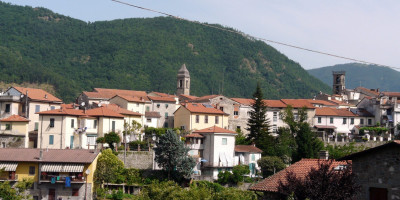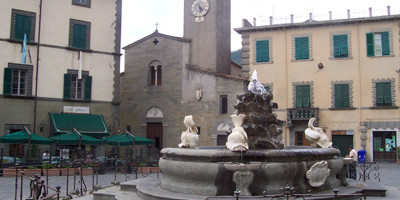Fivizzano
Nota per la storia, per il folklore e per la spiccata cultura umanistica, Fivizzano è uno dei centri più interessanti della Lunigiana. Per le sue singolari caratteristiche nel corso dei secoli si è conquistata diversi soprannomi: “Terra insigne”, “paese dalle belle finestre”, “bel cantuccio di Firenze” e “Atene della Lunigiana”, la città è nata come e cresciuta grazie alla funzione di stazione di sosta, fondamentale prima di affrontare il valico montano che divide – non lontano da qui – la strada fra Lucca e Parma (l’antica Via Nuova Clodia).
Leggi la storia Fivizzano su logo toscana ovunque bella Fivizzano – Amori e prigionieri nella Firenze di Lunigiana – Toscana Ovunque Bella Fivizzano Amori e prigionieri nella Firenze di Lunigiana La storia del Conte Giuseppe Maria Felicini, il Don Rodrigo di FivizzanoLeggi la storia
Nel Medioevo Fivizzano era identificata col Castello della Verrucola, ampliato nella prima metà del XIV secolo da Spinetta Malaspina e ancor oggi visibile sulla collina davanti al paese. Governato dai Malaspina per secoli, il borgo passò nel 1477 sotto il dominio di Firenze, città per cui questo territorio – circondato dalle repubbliche di Lucca e Genova, dai Ducati di Massa e Carrara, Parma e Modena e dal Marchesato di Fosdinovo – diventò un centro strategico, nonché un importante punto d’incontro per gli scambi commerciali.
Nel bel centro storico del paese sono visibili le antiche mura volute da Cosimo de’ Medici nel 1540, così come il Palazzo e la tomba dell’arcade Labindo e la bella fontana del 1683, costruita per volontà di Cosimo III in stile barocco. La grande Piazza medicea è ancor oggi il centro della vita fivizzanese, con la chiesa prepositurale restaurata dopo i gravi danni subiti in seguito al tremendo terremoto che nel 1920 colpi il paese.
Forse potrebbe stupire qualcuno ma Fivizzano ha rivestito un ruolo niente affatto marginale nella cultura umanistica nazionale, proprio qui infatti Jacopo da Fivizzano aprì una delle prime stamperie di tutta Italia, nella quale fu ideata e utilizzata la prima macchina da scrivere mai costruite. In suo onore è stato allestito all’interno del Palazzo Fantoni, un antico edificio signorile recuperato da un illustre medico e scrittore fivizzanese, Loris Jacopo Bononi, il Museo della Stampa. Un importante ruolo nella storia culturale della città è stato poi rivestito dall’Accademia degli Imperfetti, istituzione sorta nel 1500 che continuò con fervore la sua attività sino ad arrivare a rendere possibile la costruzione del Teatro degli Imperfetti – inaugurato nel 1807 e provvisto di ben seicento posti a sedere. Gli amanti delle lettere non mancheranno poi di visitare il complesso degli Agostiniani e la relativa biblioteca, dotata di una bella collezione di opere provenienti dall’annessa chiesa; l’ostello e, sull’esterno, il monumento in bronzo che ricorda l’origine fivizzanese di Niccolo V, il Papa che ideò la biblioteca vaticana.
Appena fuori dal cuore del paese si può ammirare il Castello della Verrucola, voluto da Spinetta Malaspina, e oggi residenza dello scultore Pietro Cascella. Una volta da queste parti sono certamente da visitare anche la Pieve di San Paolo di Vendaso, il borgo di Soliera col suo santuario della Madonna dei Colli, le belle frazioni di Gragnola, di Vinca (alta sulle Apuane e con un pane inimitabile), e Ceserano (nota per la fattoria e i vigneti del Conte Picedini-Benettini). Il grande territorio di Fivizzano è del resto conosciuto come “terra dei cento borghi” e come ultimo tra quelli che segnaliamo vale certamente la pena indicare Equi Terme, rinomata sede termale in cui è possibile visitare delle belle grotte.
Fivizzano è una meta ideale per gli amanti della natura, gran parte del suo territorio è infatti compreso all’interno del Parco Nazionale dell’Appennino Tosco-Emiliano e di quello Regionale delle Alpi Apuane. A chi piacciono i parchi potrebbe interessare l’Orto Botanico di Frignoli, così come una visita all’alpestre paesino di Sassalbo (sede del Parco Nazionale).
Gli amanti del folklore possono visitare Fivizzano in estate, quando la cittadina si trasforma in una esemplare giostra d’arme. I fatti rievocati nell’occasione risalgono al 1571, quando nella Piazza Medicea si tenne una singolare sfida fra gli arcieri del quartiere Terra e quelli di Guardia, Verrucola, Fittadisio e Montechiaro: il duello consisteva nel tirare con l’arco una freccia che doveva colpire un bersaglio a 30 metri di distanza. Dal 1971 ogni luglio si rinnova questa antica tradizione che prende il nome di Disfida fra Arcieri di Terra e Corte, grazie a cui si assiste, nella bella cornice della città imbandierata, alla suggestiva sfilata di oltre trecento figuranti in costume cinquecentesco accompagnati da sbandieratori, musicisti e cavalieri. [da www.visittuscany.it]






